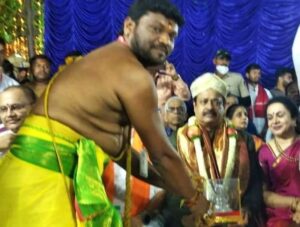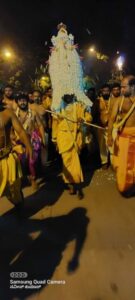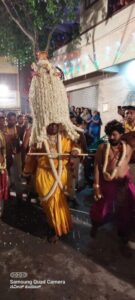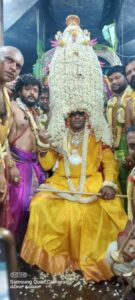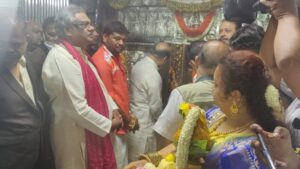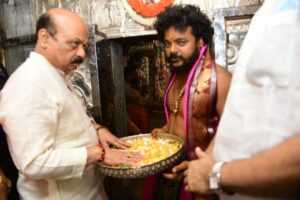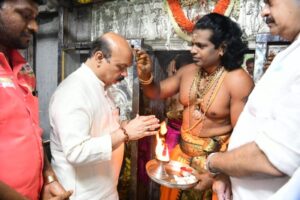Pramesh S Jain & Dr B Thomas (Special correspondent)
Karaga is a folk dance of Karnataka and parts of Tamil Nadu which originated as a ritual dedicated to Draupadi as known in these parts as Droupadmma.
The ritual is performed on a full moon day.The ritual pot filled with water and adorned with decorations several feet high is carried by the priest.
Despite heavy rainfall in the city,a huge crowd of devotees thronged the annual Karaga festival organised by Sree Dharmaraya Swamy Temple in Thigalarpet,on Saturday night.
At a time when certain parts of Karnataka are witnessing a communal flare-up over trivial issues, the centuries-old Karaga Mahotsava in the heart of the IT capital presents a fine blend of social unity and communal harmony
The procession includes a visit to the Hazrat Tawakkal Mastan Dargah in Cottonpete.
Karnataka CM Basavaraj Bommai too visited two days back and seeked the blessings from the priest,A Gnanendra Swamy,this is 11th consecutive year of the priest at Dharmaraya Swamy Temple.
M
eanwhile,the South Bengaluru MP Tejasvi Surya,in a series of tweets,explained the significance of this grand carnival in the state.
In his tweets,Surya mentioned that this annual Karaga festival is an unbroken tradition of 800 years,which takes place every year during the month of Chaitra at the Dharmaraya Swamy Temple.
According to Surya,the rituals are conducted traditionally by ‘Vahnikula Kshatriya’ or the Thigala community.
The festival starts on the 7th day of Chaitra month with ‘Dwajarohana’ – the ceremonial flag hoisting ‘Hasi Karaga’ or the holy pot is installed/worshipped at Sampangi Tank area for six days.
Later, it is carried to the Dharmaraya Swamy Temple where it becomes ‘Karaga’,” he tweeted.
He also mentioned that the festival is celebrated each year to mark the return of Draupadi in the form of Adishakti,as she promised at the time of her death.
On the 9th day of the festival,the Veerakumaras take the Karaga on a procession dancing and dazzling swordplay,symbolising their protection of the deity.
During the Mahabharata,Draupadi had created Veerakumaras,a mini-army of brave sons to defeat the demon Timirasura.
A priest dressed in female attire,embodying Draupadi,leads the spectacular procession.
The Thigalaru community have played a vital role in continuing the tradition for generations Youngsters have shown great interest over the years in volunteering to become ‘Veerakumaras’ The festival has forged a sense of identity and belonging for the people of all ages.
It was a commendable effort by the community and support from the public to conduct the festival after 3 years of a pause due to COVID-19 pandemic.I am grateful to witness and be part of this annual festival he tweeted.
Very fortunate to offer my special prayers, Preside and flag off Historical, World famous Bengaluru Karaga Utsav of Dharmarayaswamy Temple, Chickpet Constituency.@BSBommai @blsanthosh tweeted by Uday B Garudachar.Chickpet MLA.
he festival concludes with a ‘Vasantotsava’ on the 11th day and the flag is unfurled.
Even with Bengaluru’s rapid development over the years,the Karaga ritual rekindles affiliation between its people and city’s rich heritage,he concluded.
This year, the festival was organised after two years of the Coronavirus pandemic.
Karaga is a floral pyramid resting on a mud pot, symbolic of Draupadi.Interpreting the word, some say, ‘ka’ means without using hands, ‘ra’ means balancing on the head,and ‘ga’ means moving.
The floral pyramid weighs 15 to 20 kilos.It requires the priest carrying it to build his physical stamina in a local garadi mane (Kannada for wrestling house) for six months.
The festival is celebrated by Vahnikula Kshatriyas, also called Thigalas, a Tamil-speaking community of horticulturists.
In course of time, it came to be a more broad-based festival, embracing all communities.
“Because of the Deccan Sultanate and the Persianisation of culture, there was a change in the lifestyle of the ruling class.
They wanted gardens and skilled people to create them.This caused a big migration of Thigalas from north Tamil Nadu to Bangalore in the 17th century,” a historian says, wishing not to be named.So flowers became a big part of rituals,he says.Mostly jasmine.
Suresh Moona,an expert on Bengaluru’s history, shares what he was told by an elderly Thigala: “Jasmine flowers have a strong scent.It helps the priest focus as he dances while balancing the karaga on his head.”
Oral histories are open to interpretation and so is the Karaga.It is held during Chaitra,the first month in the Hindu calendar, just after the harvesting season.
After the harvest,sometimes land becomes barren.I think Karaga is a cult related to invoking fertility,” the historian says.
Likewise, another devotee, a 23-year-old political researcher and a Thigala,says it is a worship of different elements of nature.We go from one lake to another for puja,she says.
All lakes and parks where the Thigalas offer worship,now staggered across a busy commercial district,are on lands they once owned or cultivated,many in the community claim.
The festival is also an exercise in gender fluidity.
The Karaga priest dresses up in a sari,borrowing his wife’s mangalsutra and bangles and performing a hypnotic dance till he is transformed into Draupadi.
At this point,it is difficult to overlook that a festival in honour of Draupadi,a woman of power, neither has a female Karaga carrier nor women’s participation in all rituals.
Many justifications are given:
The pot is heavy for women to carry; menstruating women are impure for rituals; the crowding makes it unsafe for women.
An elderly Thigala,argues women do play a role:
They are present even during the goat sacrificing ritual.”Anusha sees sociological value in the way the festival plays out:
To see so many thousands of men worship a woman is inspiring and empowering.
The BBMP had allocated Rs 50 lakh to temple authorities for the festivities.A tight security was in place, CCTVs were installed and BBMP health staff were deputed along the procession route.
The procession that began from Sri Dharmarayaswamy temple was to pass through 38 km of illuminated stretches around the city and reach the temple back by Sunday morning.
Over the last two years,the Karaga,which has a history of over 900 years,was celebrated within the temple premises without allowing any crowds,because of the Covid situation.






